#mårten eskil winge
Text

Hjalmar bids farewell to Örvar-Oddr after the Battle of Samsø
by Mårten Eskil Winge
#mårten eskil winge#hjalmar#örvar oddr#duo#swedish#hervarar saga#tyrfing#art#sagas#saga#norse mythology#gesta danorum#germanic#mythological#europe#samsø#history#mythology#european#scandinavian#scandinavia#old norse#nordic#sweden#northern europe#germanic heroic legend#battle of samso#orvar oddr#örvar-odds saga#blood brothers
183 notes
·
View notes
Text

Tor's Fight with the Giants (Mårten Eskil Winge, 1872)
9 notes
·
View notes
Text

Hjalmar Bids Farewell to Örvar-Oddr After the Battle of Samsø by Mårten Eskil Winge (1866)
132 notes
·
View notes
Photo
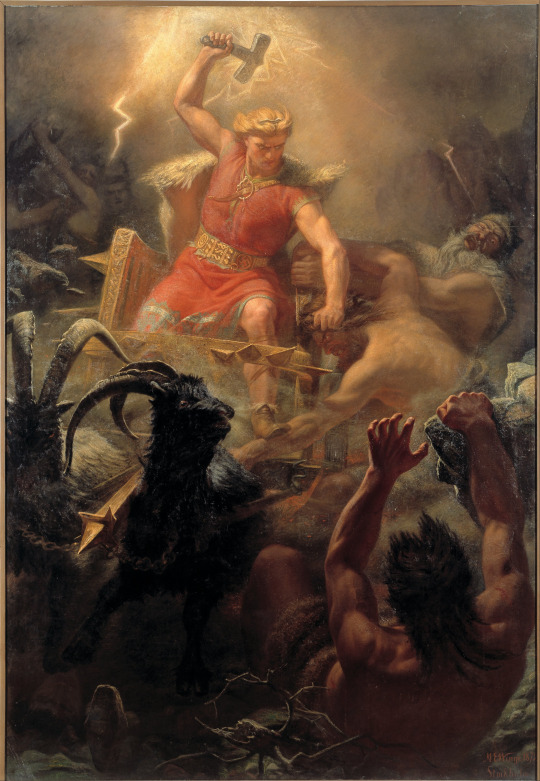

Tor's Fight with the Giants by Mårten Eskil Winge (1872) + The Prestige by Christopher Nolan (2006) - See previous post.
Whereas we have said that it is the Angels who carry down into the individual human beings that which the Archangels bring about, so also an ‘I’ which awakes at such an early elementary stage of soul-life, is above all interested in having the affairs of the Archangels carried into it, as it were. Hence the Germanic Scandinavians have an interest in an angelic figure who possesses special power, but who at the same time is closely related to the separate human being and his individuality. That angelic figure is Thor. Thor can only be recognized by knowing that in him one must recognize a Being who might indeed have been very advanced if he had evolved himself normally further, but who made the renunciation comparatively early, and remained behind at the stage of the Angel, in order that at the time when in the course of the soul's evolution the ‘I’ should awake, he might become a guide in the soul-world of the Germanic Scandinavian countries. What one feels so directly in Thor as being related to the individual human ‘I’ is that which was to be carried into every single ‘I’ from the spiritual world, could actually be so carried in. If we bear this in mind we shall also better understand many things that have been handed down. For us it is a question of being able to understand these individual Gods correctly. The Germanic Scandinavian man perceived and experienced this imprinting of the soul into the body. He was present when the ‘I’ membered itself into the body and took possession of each single human being.
...
Just as that which lives in us and organizes our speech,—that is to say, in the way speech existed among the Scandinavians—just as that presses through into the ‘I’ and produces the pulsation of the blood, so does that which organizes itself into speech correspond outside in the macrocosm to thunder and lightning. Speech is there before the ’I’ is born. Hence the ‘I’ is everywhere felt to be the son of that Being who gives speech. In the imprinting of the separate ‘I’ Thor is specially concerned, and that which in the microcosm corresponds to the event in the macrocosm, is the pulsation of the blood. That therefore which outside in the macrocosm corresponds to the pulsation of the blood in man, is what as thunder and lightning goes through the sighing winds and weaving clouds. That again is seen by the Germanic Scandinavian in his clairvoyance as unity, and he sees that the movement of the wind, the flashing of the lightning outside is inwardly connected with the weaving of the air he breathes in. He sees how that passes over into the blood and then causes the ‘I’ to pulsate. That is looked upon as a material occurrence at the present day, but it was still an astral one to the Germanic Norseman. He saw the inner relationship of fire and lightning, with that which goes through the blood. He felt the pulse-beat in his blood and he knew that it was the beating of the ‘I.’ He knew: ‘That which thus beats I am able to perceive, and I shall be able to perceive it again in a little while.’ But he did not notice the outer material event. All that was clothed in clairvoyant perception. He perceived that which caused his pulse to beat and made him return again and again to the same places, as being the act of Thor. He felt the Thor-force in his ‘I’ as the constant returning of the hammer of Thor into the hand of Thor, he felt the force of one of the most powerful Angels that had ever been known and revered, because he was a mighty Being who was seen to have remained behind at the Angel stage.
—Rudolf Steiner, The Mission of Folk-Souls in Connection with Germanic Scandinavian Mythology: Lecture VIII
0 notes
Text

A drawing I did of Zhuzhi-lang and Tianlang-jun based on Loki And Sigyn by Mårten Eskil Winge
9 notes
·
View notes
Text
Myth!Loki's Hair Color: Common Depictions
Because the AI user that just annoyed me also claimed myth!Loki's canonical hair color is blonde and that's why they did that crappy blonde MCU!Loki AI art, and I am feeling spiteful cus fuck AI and that eyesore, and I need to wash that off my brain.
AND I KNOW this claim came from those people that interact with THAT ONE VERY obnoxious Sigyn stan that pretends to be a Norse mythology expert despite never providing proper citations or citing modern myth re-tellings and whines about children's story books not being accurate. Ask her to cite her claims and actually look at the sources, for the love of Loki!
LOKI HAS NO KNOWN HAIR COLOR IN THE MYTHS! THERE's NO SOURCE FOR THAT! Loki's also a shape-shifter! Loki can have their hair look like whatever the fuck they want. To my knowledge, the only gods that have confirmed hair colors are myth!Thor, who is said to a red-head, and myth!Sif being a blonde who gets a wig of magical gold to substitute her chorn hair. There's also a description of myth!Heimdall who is said to be the "whitest" god, implying blonde/white hair? Loki's only mentioned to be pretty, assumed to be Aesir -sized rather than gigantic, likely smaller than myth!Thor because myth!Thor can kick his ass and he can hold onto Thor's belt when crossing a river (Skáldskaparmál), and have scars on his lips due to them being sown shut.

Also from Gylfanning: "Loki is beautiful and comely to look upon, evil in spirit., very fickle in habit. He surpassed other men in that wisdom which is called 'sleight,' and had artifices for all occasions; he would ever bring the Æsir into great hardships, and then get them out with crafty counsel."
There's also the Snaptun stone, believed to be Loki due to the scarred lips, giving him a mustache.
The most common and widespread hair color depictions of Loki have red/ginger/orangey hair due to Loki mistakenly being thought to associated with fire because their name's too similar to the fire personification Jotun's name, Logi, because Richard Wagner fucked up in his Ring Cycle Operas and combined the two of them into "Loge". Arthur Rackham's illustrations based on Wagner's Ring Cycle are possibly the most influential in that regard because they're fucking awesome. Even GOW made their Loki depiction a red-head.
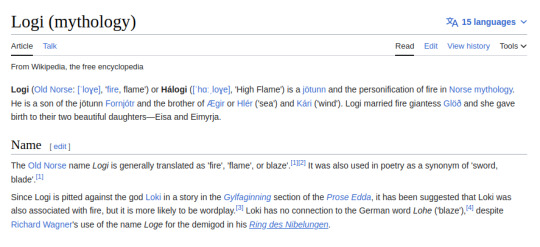
And here's a painting that looks like a ginger to me by James Doyle Penrose (1912):
The second most common hair color depiction is black hair, probably thanks to Marvel as it's most prevalent in modern depictions (e.g. Alan Cumming's Loki in "Son of the Mask", whom I fucking love).
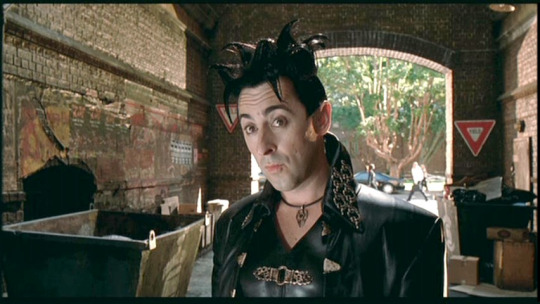
There's also the Valhalla comics that started in 1979 (after Marvel, but I don't think that contributed AT ALL because Vallhala comics are way more myth-accurate and fucking awesome. I am just including it here because it's a black-haired Loki depiction).
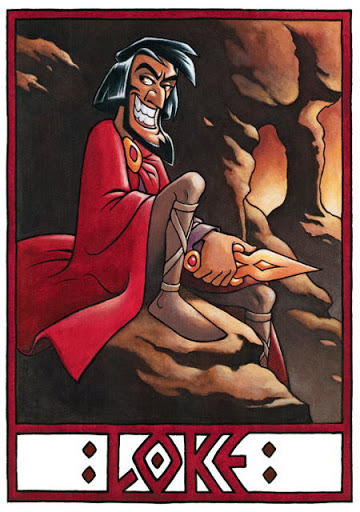
There's also Eric M. Esquivel's Ragnarok n' Roll (have not read and I am not inclined to do so, but it kept showing up in my loki searches 10+ years ago and its existence was archived in my brain due to that). Is it me or does he looks like Cantinflas because of the mustache?

This is Cantinflas btw

There's also Jul I Valhall Loke (Thanks Scandinavian Twitter users for showing me this gem even if I can't understand the language. I am forever grateful.)
youtube
And surprisingly, Marvel was not the first to give him black hair. Marten Eskil Winge portrayed Loki with black hair in his 1863 painting "Loki and Sigyn."
Neil Gaiman has depicted Loki with a variety of hair colors, USUALLY as a literally "fiery" red-head (Sandman comics & American Gods book), whatever Johnathan Tucker's hair color is in the American Gods TV show, and black-haired (Norse Mythology graphic novel).



There's a brown-haired Loki depiction in Assassin's Creed (I have not played it btw).

And sometimes he's just some demonic thing with horns:

#i have a weird belief myth!loki's hair is brown because no one comments on it#myth!loki#norse mythology#valhalla comics#the life and times of juniper lee#neil gaiman#american gods#arthur rackham#richard wagner#son of the mask#alan cummings#marten eskil winge#sandman#assasin's creed#marvel comics#mcu#jul i valhal#james doyle penrose#peter madsen#eric m. esquivel#idw comics#atreus#god of war#LokiInMedia#IStartShit#hot takes#Youtube
12 notes
·
View notes
Text

'Loke and Sigyn'. Mårten Eskil Winge. 1863.
42 notes
·
View notes
Text
So, I should have been storytelling at Thunorsmoot during the past weekend, but health concerns got in the way. Anyway, here's a poem I wrote to try set the mood for it.
#north sea poet#heathenry#nico solheim-davidson#poetry#my poetry#heathen#thor#Thunorsmoot#Þórr#Bragi#Heathen poetry#inclusive heathenry#asatru uk
3 notes
·
View notes
Text
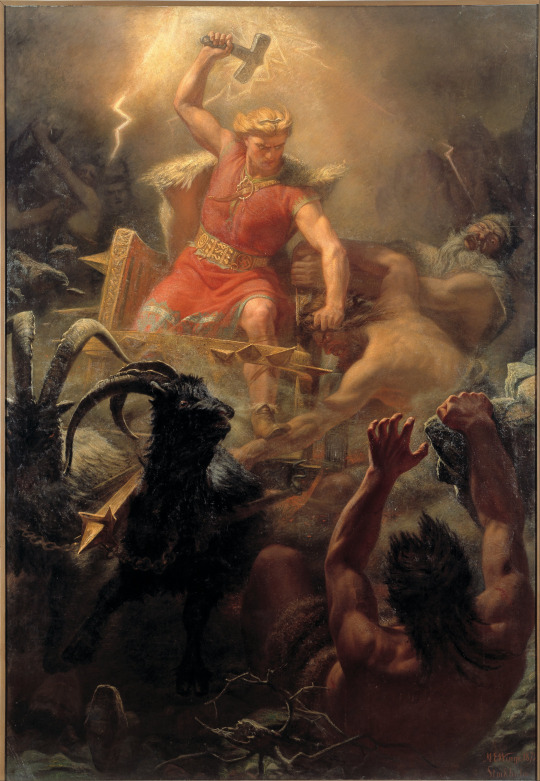
Mårten Eskil Winge
Thor's Fight with the Giants, 1872
2 notes
·
View notes
Text

Today, July 31st, our old #Norse Friends (and some who today are modern #Pagans and #Wiccans) wou9ld be celebrating the Day of #Loki and #Sigyn’s!
● Loki: wily #trickster God
(https://norse-mythology.org/gods-and-creatures/the-aesir-gods-and-goddesses/loki)
● Sigyn: the wife of the wily trickster God Loki
(https://norse-mythology.org/sigyn/)
Painting:
“Loki” by Mårten Eskil Winge (1890)
details:
(https://commons.wikimedia.org/wiki/File:Loki,_by_M%C3%A5rten_Eskil_Winge_1890.jpg)
0 notes
Text

Thor's Fight with the Giants (Tors strid med jättarna) by Mårten Eskil Winge
The modern Swedish word for atmospheric thunder - åska - "the god's ride" - retains the name. That Thor caused lightning and thunder was still a living tradition in the countryside when compulsory education started teaching what was known from the Eddas.
#thor#giants#art#mårten eskil winge#nordic#norse#old norse#mythology#mythological#norse mythology#sweden#swedish
196 notes
·
View notes
Text

Tor's Fight with the Giants (1872) by Mårten Eskil Winge
0 notes
Text
Thor's Fight with the Giants – Mårten Eskil Winge, 1872. [Nationalmuseum, Stockholm].

1 note
·
View note
Text
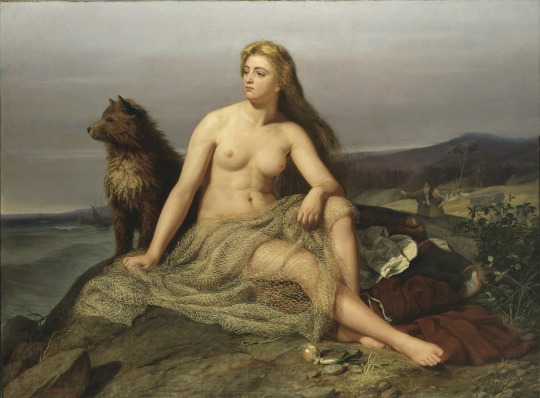
Mårten Eskil Winge - Aslaug (1862)
122 notes
·
View notes
Photo
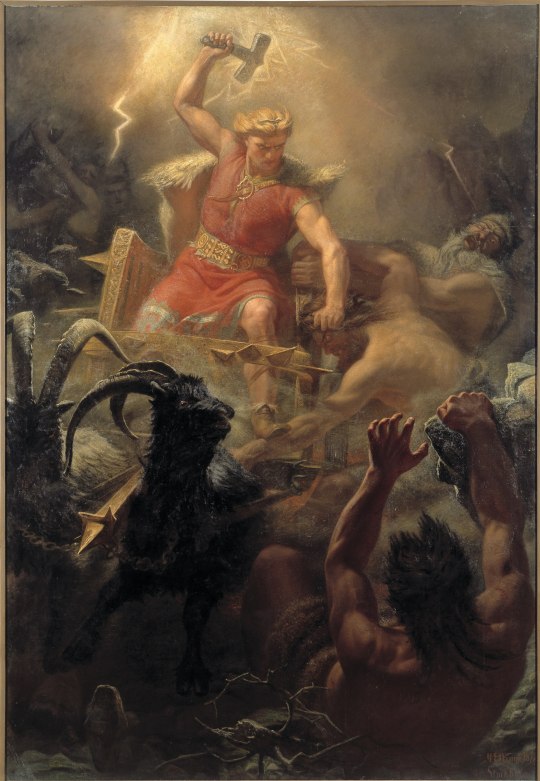
Mårten Eskil Winge (September 21, 1825 – 1896) was a Swedish artist. He was a professor at the Royal Swedish Academy of Arts and associated with the Düsseldorf school of painting, due to his studies in Düsseldorf. He also traveled to Paris and Rome before returning to Sweden.
His art was influenced by the Norse mythology themes, and in addition he created a number of altar pieces in Sweden, and illustrated books, for instance by Danish Romantic poet, Adam Oehlenschläger.
Above: Tor's Fight with the Giants, 1872 - oil on canvas (Nationalmuseum, Stockholm)
#art#swedish painter#mårten eskil winge#Royal Swedish Academy of Fine Arts#düsseldorf#düsseldorf school of painting#norse mythology#thor#tor#giants#adam oelenschläger#nationalmuseum stockholm
21 notes
·
View notes
